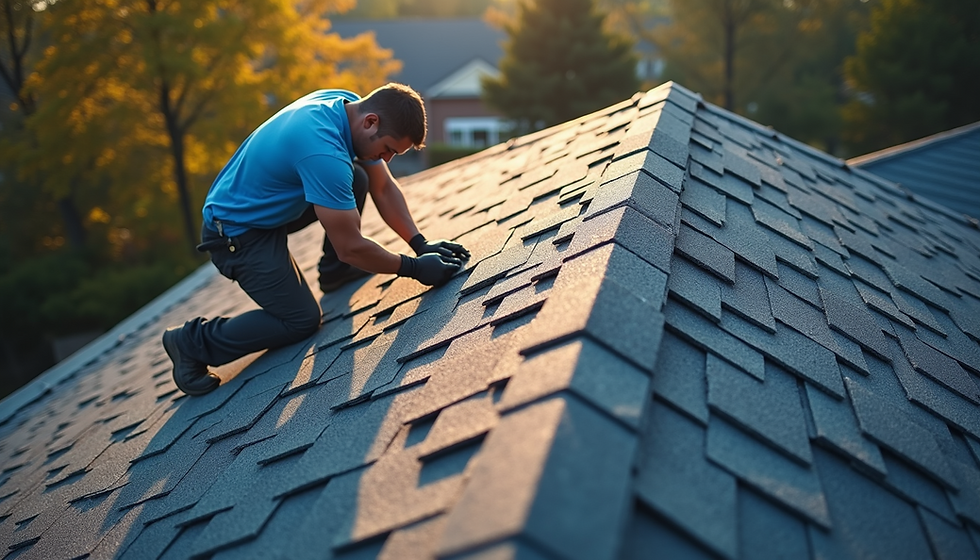Repair Roof Damage with Confidence
- James Creed
- Sep 3
- 3 min read
When your roof shows signs of wear or damage, it can be stressful. A damaged roof threatens your home’s safety and comfort. Knowing how to fix roof damage confidently can save you money and prevent further issues. This guide will walk you through the essential steps to assess, repair, and maintain your roof effectively.
Understanding How to Fix Roof Damage
Fixing roof damage starts with understanding the problem. Roof damage can come from many sources: storms, falling branches, aging materials, or poor installation. Common issues include missing shingles, leaks, cracks, and damaged flashing.
Steps to identify roof damage:
Inspect your roof after severe weather.
Look for missing or curled shingles.
Check for water stains on ceilings or walls inside your home.
Examine flashing around chimneys, vents, and skylights.
Look for granules in gutters, which indicate shingle wear.
Once you identify the damage, you can decide whether to repair it yourself or call a professional. Small issues like a few missing shingles can often be fixed with basic tools and materials. Larger problems, such as extensive leaks or structural damage, require expert help.

Practical Tips to Fix Roof Damage Safely and Effectively
Repairing your roof requires safety and precision. Here are practical tips to help you fix roof damage with confidence:
Safety first: Use a sturdy ladder and wear non-slip shoes. Consider a safety harness if your roof is steep.
Gather the right tools: Hammer, roofing nails, roofing cement, replacement shingles, utility knife, and a pry bar.
Remove damaged shingles: Carefully lift the edges of surrounding shingles and remove nails holding the damaged ones.
Install new shingles: Slide new shingles into place and nail them securely. Seal edges with roofing cement.
Check flashing and seals: Apply roofing cement around flashing to prevent leaks.
Clean up debris: Remove nails and old shingles from your yard to avoid injury.
If you want to learn more about how to repair roof damage professionally, this resource offers detailed guidance and services.

Can You Repair Just a Section of a Roof?
Yes, you can repair just a section of a roof, especially if the damage is localized. Partial repairs are common and cost-effective when the rest of the roof is in good condition. Here’s how to approach it:
Identify the damaged area: Mark the section that needs repair.
Remove damaged materials: Carefully take out shingles, underlayment, or flashing in that area.
Inspect the roof deck: Check for rot or structural damage. Replace any compromised wood.
Install new underlayment and shingles: Match the new materials with the existing roof.
Seal and secure: Use roofing cement and nails to ensure a watertight repair.
Partial repairs extend the life of your roof and prevent minor issues from becoming major problems. However, if damage is widespread, a full roof replacement might be necessary.

When to Call a Professional for Roof Repairs
While DIY repairs can handle minor issues, some situations require professional expertise:
Extensive damage covering large areas.
Structural damage to the roof deck or supports.
Complex roofing materials like slate or tile.
Persistent leaks despite repairs.
Safety concerns due to roof height or steepness.
Professional roofers have the experience, tools, and materials to fix problems correctly and safely. They can also provide warranties for their work, giving you peace of mind.
Maintaining Your Roof to Prevent Future Damage
Preventing roof damage is easier than fixing it. Regular maintenance keeps your roof in good shape and extends its lifespan.
Maintenance tips:
Clean gutters regularly to prevent water backup.
Trim overhanging tree branches to avoid damage from falling limbs.
Inspect your roof twice a year and after storms.
Remove debris like leaves and moss.
Check attic ventilation to prevent moisture buildup.
Routine maintenance helps you spot problems early and avoid costly repairs.
Taking care of your roof is essential for protecting your home. By understanding how to fix roof damage, knowing when to repair just a section, and maintaining your roof regularly, you can keep your home safe and dry for years to come. Whether you choose to DIY or hire a professional, confidence in your approach will ensure the best results.




Comments